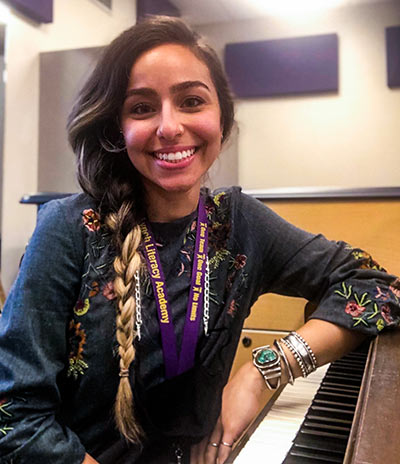Editor’s Note — This article is part of an ongoing series spotlighting different methods, lessons and creative strategies that teachers are using to educate students during a pandemic.
Early last March, as Amsterdam choir students went into final rehearsals for their All-City Chorus Festival, there was news about something going on with a virus. Mid-month, costumed teens performed their songs with practiced choreography to a packed house on a Wednesday night, and two days later, all New York public schools shut down for the rest of the school year.
“We haven’t sung together since,” said choir teacher Dalisa Soto-Peruzzi.
So, then, how does she teach? And how are students continuing to learn singing when school is sometimes open, sometimes not?
There is no playbook for teaching in a pandemic.
But since Soto-Peruzzi has been teaching music for nine years in what she calls her “dream job,” she knew it was essential to continue educating students with interaction in a subject that promotes comity as well as musical skills. Within two weeks of the pandemic shutdown, she began offering live instruction through Google Meet.
 “It feels like my first year. I feel like a novice,” said Soto-Peruzzi, a member of the Amsterdam Teachers Association led by co-presidents Eugene Agresta and Richard Peters. The Montgomery County district is located mainly on the north bank of the Mohawk River that cuts through town.
“It feels like my first year. I feel like a novice,” said Soto-Peruzzi, a member of the Amsterdam Teachers Association led by co-presidents Eugene Agresta and Richard Peters. The Montgomery County district is located mainly on the north bank of the Mohawk River that cuts through town.
There has been much to learn. For instance, if all the students have their computer microphones on while singing, the feedback can screech and bleep out into the stratosphere. So, the students sing – but they are on mute.
The 300 students in different classes could hear Soto-Peruzzi sing, and learn their parts. But she couldn’t hear them. At least, not at that instant.
They recorded themselves, and then sent the recording to her.
The district has online music recording software, and so Amsterdam’s four music teachers are able to mix separate audio files. Soto-Peruzzi said the district also made sure each student had laptops or Chromebooks, and they provided hot spots for Internet access.
Using this technology, students put together a performance for this past spring’s eighth-grade commencement, an annual tradition.
The Amsterdam school district is a rural district diverse with families who go back generations here, as well as those from Puerto Rico, Central and South America. Spanish was the first language of Soto-Peruzzi, who spent her first five years in the Dominican Republic after being born in Queens, and she loves being able to speak it with some of her students.
“Through music, a lot of kids find their voice, and share who they are and what they represent,” she said, recalling her gratitude at being able to attend public schools in New York City where she could take part in music and performing arts.
When New York State’s public schools resumed in-person learning in September while the pandemic’s intensity waned, most students came to the building. Soto-Peruzzi said research showed that singing in person would release aerosols at a rate similar to someone screaming, so that was nixed. So was band. In order to be safe, students would have to be 12 feet apart, and that wasn’t possible.
Further research showed that if they were six feet apart, wearing masks, they were safe humming.
“We just hum everything…to harmonize, and to warm up our voices,” she said. Students are animated when seeing each other, and they liven up.
Those who are quarantining, or have health issues, take part in the class online. So the choral teacher speaks with students in front of her, and on the screen, as do so many other teachers now.
“The kids are always with me live,” said Soto-Peruzzi. “They can connect with friends; it still feels like community. It feels like, for my subject specifically, live instruction is the best for the socio-emotional needs of the students.”
School closed again for several weeks prior to the holidays, and then reopened. For educators and students, school shifts from in-person to remote as the greedy pandemic spikes.
Much happens outside the music classroom as well. Music students have been provided with their own accounts for sound recording programs to create digital beats, tracks and loops and record vocal audio.
They kicked it up for the holidays, remixing their favorite holiday songs from Christmas, Kwanza, Hanukkah and other celebrations with their own spin. They learned one song in Hebrew. Rap, trap, rhythm and blues, rock, Caribbean and salsa all came streaming in. Boom, snap, bring it.
“There are so many different genres. It was such a gift,” she said. The 2020 edition of the Choral Holiday Mix Tape was born, and it was shown to residents of three local nursing homes whom the students usually visit in person for caroling.
“We took this year as an opportunity to grow,” said Soto-Peruzzi, who recognizes that the days are long with teaching, mixing and recording. Music, for her, is not just a career, however. She is also a performer and believes music is healing.
Meanwhile, for students, songwriting is also a form of journaling.
“Music is a universal language,” she said. “It’s powerful.”
"Dalisa is just one of many ATA members who have met the challenges of remote instruction head-on by adapting her class to reach as many students as possible," said Agresta. "Plus, you would never know to look at her that she's working through the most stressful period in her teaching career. Her calm and encouraging words keep her students on an even keel, and some will even swear that they can see her smile through her mask."